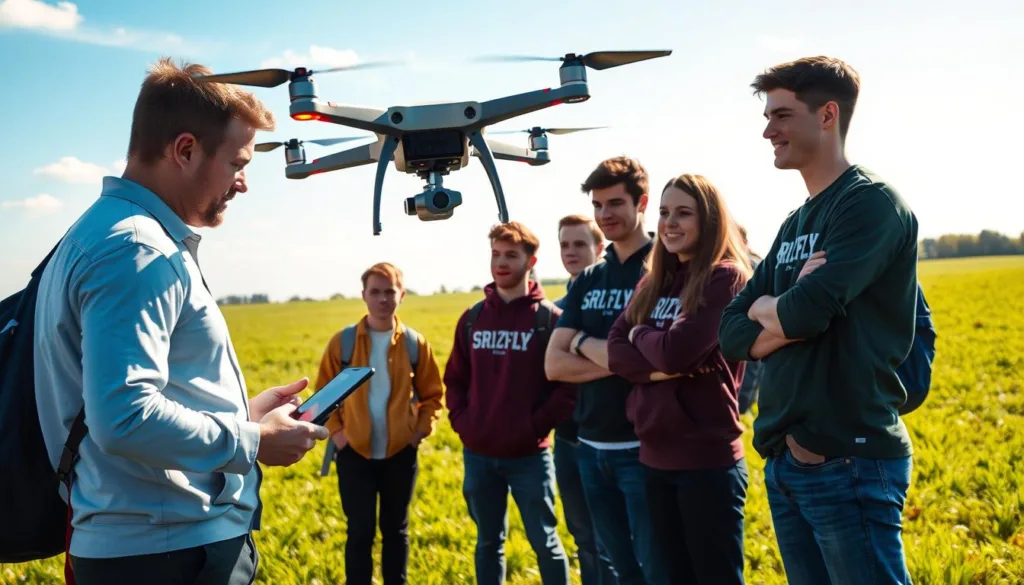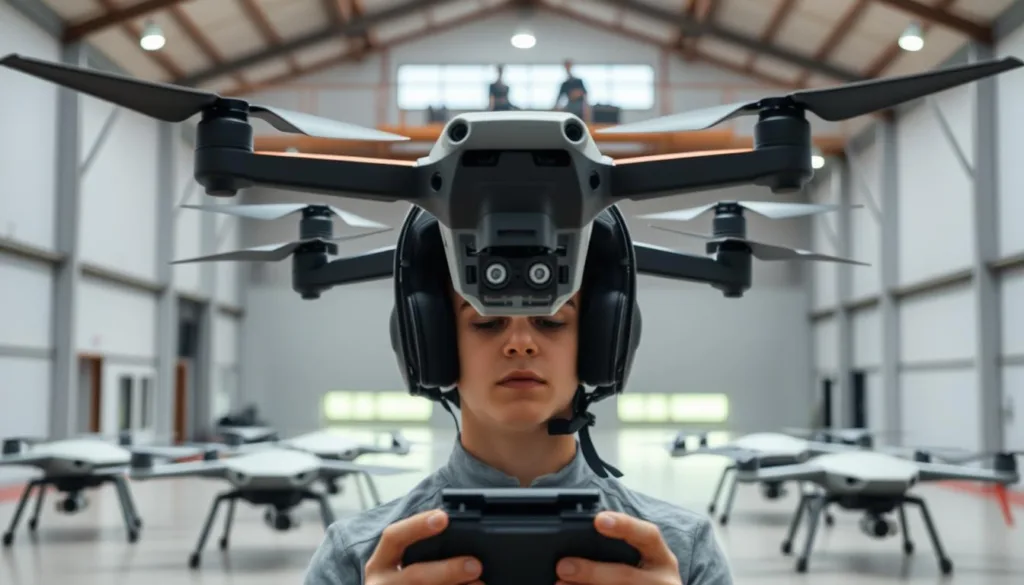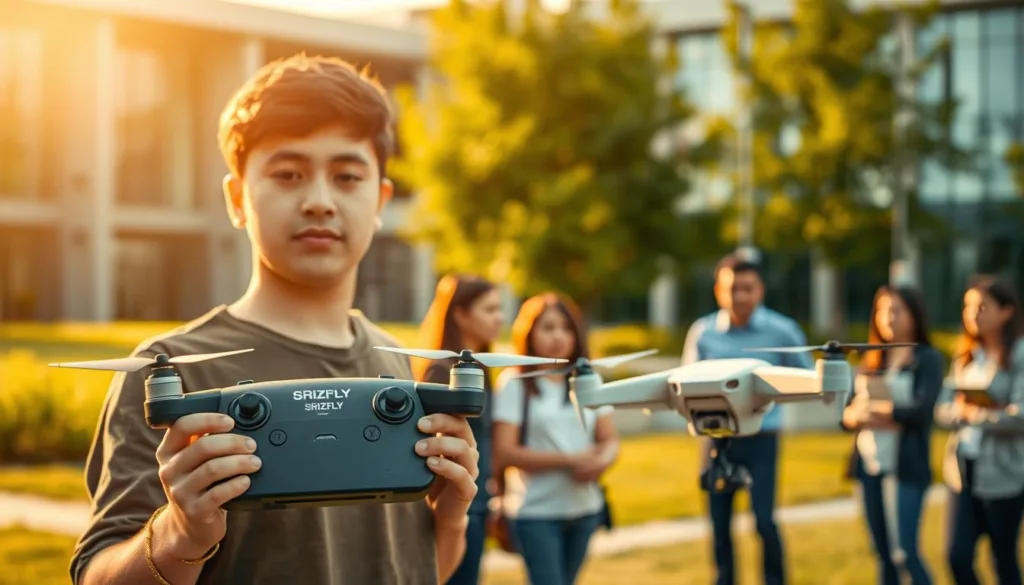The demand for skilled drone operators is on the rise, making drone pilot certification for students a vital step for those looking to enter the burgeoning field of unmanned aerial vehicles (UAV). As students embrace opportunities in diverse industries such as agriculture, filmmaking, and emergency services, obtaining a Remote Pilot Certificate from the FAA equips them with the knowledge and skills necessary for safe and effective drone operation. Through targeted student drone certification programs and specialized student drone pilot courses, educational institutions can empower the next generation of drone pilots to navigate this dynamic technology landscape with confidence.
Key Takeaways
- The importance of drone pilot certification for students in the US.
- Benefits of enrolling in student drone certification programs.
- An overview of the Remote Pilot Certificate requirements.
- Career paths opening up due to student drone pilot courses.
- The role of educational institutions in fostering drone expertise.
Importance of Drone Pilot Certification for Students
As the demand for skilled drone operators continues to rise, the significance of obtaining a drone pilot certification becomes clearer for students. This certification not only equips individuals with essential skills but also serves as a valuable asset in a competitive job market. Students who pursue this credential stand to gain considerable benefits of drone certification, making them attractive candidates for potential employers.
Benefits of Certification
Achieving drone pilot certification provides numerous advantages. Learners acquire in-depth knowledge regarding regulations, safety, and operational proficiency. This practical training enhances their confidence and efficiency while flying drones. In addition, certification helps students stand out among their peers, greatly improving job prospects and opening doors to various industries.
Career Opportunities in UAV
The UAV industry offers a wealth of career opportunities in UAV. Interested students can find roles in sectors such as logistics, agriculture, public safety, and infrastructure inspection. As technology advances, the need for certified drone operators is expected to grow, resulting in further job openings. This environment underscores the importance of obtaining the necessary qualifications to enter the workforce successfully.
Enhancing Educational Programs
Educational institutions can play a pivotal role in fostering these skills through enhancing educational programs. By integrating drone pilot training into existing STEM curricula, schools can provide engaging learning experiences for students. This approach not only enriches the curriculum but also inspires the next generation to explore technology and innovation in the field of UAVs.
Overview of FAA Regulations
Understanding FAA regulations is crucial for students pursuing a career as drone pilots. Specifically, the Part 107 certification outlines essential guidelines for operating drones commercially. Aspiring pilots must navigate through various requirements to ensure compliance with these regulations.
Understanding Part 107 Certification
The Part 107 certification is a primary requirement established by the Federal Aviation Administration for drone operators. To obtain this certification, students must meet specific criteria. These include being at least 16 years old and having a solid understanding of English. This certification allows individuals to engage in commercial drone operations legally, paving the way for diverse career opportunities in various sectors.
Exam Requirements and Process
To achieve the Part 107 certification, students must pass the FAA knowledge test. This examination assesses their understanding of critical areas, including airspace regulations, unmanned aircraft operations, and emergency procedures. The exam requirements include:
- Creation of an FAA Tracking Number
- Scheduling the FAA knowledge test
- Completing the Integrated Airman Certification and Rating Application (IACRA) for certification
Successful completion of these steps ensures that individuals are well-prepared to operate drones safely and in accordance with FAA regulations.
| Step | Description |
|---|---|
| 1 | Create FAA Tracking Number |
| 2 | Schedule FAA Knowledge Test |
| 3 | Pass the Knowledge Test |
| 4 | Submit IACRA Application |
Launching a Drone Training Program
Starting a drone training program requires careful planning and execution. Establishing curriculum aligned with FAA guidelines is essential to ensure regulatory compliance and to provide students with the necessary skills in this rapidly evolving field.
Steps to Establish a Curriculum
Creating a comprehensive curriculum involves several key steps:
- Identify training objectives that match industry needs.
- Select appropriate learning materials, including textbooks, online resources, and practical exercises.
- Develop assessment methods to evaluate student progress and understanding.
Integrating FAA Guidelines
Integrating FAA guidelines into your drone training program enhances its credibility. Ensuring compliance with regulations helps students prepare for the certification process. Familiarizing students with essential FAA requirements creates a strong foundation for their future careers.
Key Equipment and Resources
To effectively implement a drone training program, it is crucial to gather the right equipment and resources. Significant components include:
- UAVs suitable for various training levels and applications.
- Simulation tools that provide a safe environment for practice.
- Partnerships with educational institutions and industry leaders to enhance learning opportunities.

SRIZFLY UAV Simulation Systems
SRIZFLY offers cutting-edge UAV simulation systems designed to enhance the educational landscape for aspiring drone pilots. These simulators provide a realistic flight training experience, allowing students to immerse themselves in life-like flying scenarios while maintaining a safe and controlled environment. The following breakdown showcases the features and advantages of using SRIZFLY simulators in educational programs.
Features of SRIZFLY Simulators
- Customizable Training Scenarios: Each simulator can be tailored to accommodate diverse learning needs and objectives, enabling students to practice specific maneuvers.
- FAA-Aligned Curriculum Support: The simulators incorporate guidelines from the FAA, ensuring that students receive training that directly corresponds to certification requirements.
- High-Quality Graphics: Visual realism enhances situational awareness, fostering better decision-making skills during realistic flight training.
- Performance Analytics: Detailed debriefing tools allow instructors to review student performance and provide targeted feedback, improving training outcomes.
Realistic Flight Training Experience
In the realm of drone education, providing a practical learning experience is vital. SRIZFLY simulators create a platform for students to engage in realistic flight training, simulating various weather conditions and emergency scenarios without the inherent risks of actual flight. By leveraging these UAV simulation systems, educational institutions can significantly enhance safety, efficiency, and the overall quality of training. This ensures that students not only understand the theoretical aspects of drone operation but can also apply their knowledge in a practical setting.
Customizable Training Scenarios
In the evolving landscape of drone education, the ability to create customizable training scenarios is vital for enhancing learning outcomes. SRIZFLY simulators provide educators with the tools necessary for tailoring drone training to meet the unique needs of each student. This flexibility facilitates the incorporation of various industry-specific operations into the curriculum.
Tailoring Scenarios for Student Needs
Educators can design training experiences that align closely with students’ interests and career aspirations. By personalizing scenarios, instructors ensure that students engage more meaningfully with the material. When training is relevant, it boosts motivation and promotes better retention of skills. Creating tailored sessions helps bridge the gap between theory and practice, equipping students for real-world challenges.
Industry-Specific Operations
Incorporating industry-specific operations into training programs is essential for preparing students for their future careers. Whether focusing on agriculture, mapping, or aerial photography, customizable training scenarios enable targeted learning. This approach allows students to practice skills directly applicable to their desired field, ensuring they enter the workforce well-prepared and proficient in handling relevant technologies.
Safety in Drone Training
Safety is a cornerstone of effective drone training programs. A strong emphasis on safe flight practices not only enhances the skills of student pilots but also protects the community at large. Robust training ensures that future drone operators are well-prepared to handle various scenarios while adhering to strict safety protocols.
Importance of Safe Flight Practices
Developing a thorough understanding of safe flight practices is essential for any aspiring drone pilot. These practices include recognizing airspace regulations, conducting pre-flight checks, and performing risk assessments. By instilling these lessons early, students build a foundation that prioritizes safety in drone operations, minimizing accidents and ensuring responsible flight.
Virtual Environment Advantages
Utilizing a virtual training environment offers significant benefits for safety in drone training. SRIZFLY’s advanced simulations allow students to practice in risk-free scenarios, replicating real-world applications without danger. This virtual setting enables learners to familiarize themselves with emergency procedures, crew resource management, and maintenance protocols, reinforcing the importance of safety in every facet of their training.

Aligning with STEM Education
Integrating drones into educational curricula enhances the learning experience by providing hands-on opportunities for students. As education systems evolve, the inclusion of UAV technology becomes increasingly relevant. Schools adopting drones in STEM programs witness significant improvements in student engagement and understanding of complex concepts.
Role of Drones in STEM Programs
Drones serve as powerful tools in STEM education by allowing students to apply theoretical knowledge to real-world situations. They encourage exploration in various fields such as engineering, mathematics, and environmental science. Programs that incorporate drones effectively teach students about aerodynamics, data collection, and coding while bolstering their critical thinking skills.
Engaging Students with Technology
Incorporating drones into the classroom captivates students and enhances their interest in technology. Engaging students with technology through drone usage not only sparks curiosity but also fosters a sense of collaboration as they work in teams. This collaborative environment promotes problem-solving skills vital for future career opportunities in high-demand tech industries.
| Benefits of Drones in STEM Education | Impact on Students |
|---|---|
| Hands-on Learning | Improved retention of knowledge |
| Real-world Applications | Increased interest in STEM careers |
| Collaboration Opportunities | Enhanced teamwork and communication skills |
| Technical Skills Development | Preparation for future technological advancements |
Preparing Students for the Future
As the drone industry continues to evolve, educational programs must focus on preparing students for the future. Developing essential skills in flight operation, data analysis, and decision-making is critical. These competencies are highly sought after in today’s job market. Institutions that embrace drone training not only enhance skills development but also open doors to emerging career paths.
Skills Development through Drone Training
Engaging in drone training cultivates skills that are important across various sectors. Students benefit from hands-on experience, allowing them to excel in areas such as operational safety and regulatory compliance. The technical proficiencies they gain will serve them well as they enter a workforce increasingly demanding drone expertise.
Industry Trends and Forecasts
Understanding industry trends in UAV is essential for students. The market is projected to grow significantly, driven by innovations and technological advancements. Familiarity with these trends empowers students, enabling them to align their skills with future job demands. Educational institutions that notify students about these developments position them advantageously for successful careers.
Testimonials from Educators
Feedback from educators reveals a transformational experience in their classrooms through the adoption of SRIZFLY programs. The educator testimonials consistently highlight the remarkable evolution of student engagement and performance, underscoring a shift towards a hands-on, high-tech learning environment.
Success Stories from SRIZFLY Users
Many educators share SRIZFLY user success stories that showcase how students excelled in their learning. These narratives often feature students gaining confidence in their skills, especially in preparation for FAA certification. Notably, several students reported successfully passing their certification exams on their first attempts, a testament to the effective training methods employed by SRIZFLY.
Positive Impact on Students
The positive impact on students emerges as a common theme within the testimonials. Educators observe not only improved academic performance but also enhanced critical thinking and problem-solving skills. Students exhibit a newfound enthusiasm for learning, driven by the interactive and immersive experiences provided by SRIZFLY’s cutting-edge simulators.
| Aspect | Effect | Student Feedback |
|---|---|---|
| Engagement | Significant increase in classroom participation | “I love using drones to learn!” |
| Confidence | students exhibit greater self-assurance in technical skills | “I never thought I could fly a drone!” |
| Academic Performance | Higher pass rates on FAA certification exams | “Passing the exam felt amazing!” |
These insights not only affirm the value of SRIZFLY technology in education but also reflect a commitment to cultivating the next generation of skilled drone pilots. Through real-world applications and robust training, educators witness firsthand the enduring benefits of innovative teaching approaches.
Collaborations and Partnerships
Building strong collaborations with technical colleges stands at the forefront of enhancing drone education. Through these partnerships, educational institutions gain access to necessary resources and expertise that facilitate specialized programs. This effort in establishing drone training collaboration can significantly improve the quality of education and training provided, ultimately benefitting the students.
Working with Technical Colleges
Collaborating with technical colleges allows for a direct exchange of knowledge and skills in the realm of drone technology. These institutions can provide students with hands-on learning experiences, crafted curricula, and access to advanced equipment. By fostering such partnerships, both SRIZFLY and educational institutions strengthen the educational framework surrounding drone piloting, promoting a culture of innovation.
Expanding Training Access
Through these partnerships with technical colleges, expanding training access becomes a tangible reality. Students from various backgrounds benefit from broadened access to specialized training programs. Offering certification courses is crucial in preparing the next generation of drone pilots for the evolving job market, ensuring they emerge as competent professionals ready to tackle industry challenges.
Conclusion: The Future of Drone Pilot Certification
Investing in drone pilot certification for students is essential for both individual career ambitions and the overall growth of the UAV sector. As technology advances, the demand for skilled drone pilots is expected to rise, making it crucial for educational institutions to adapt their curricula accordingly. By doing so, schools position their students to become leaders in an evolving job market while also fostering innovation within the industry.
Investing in Student Success
Incorporating drone training and certification into educational programs will not only enhance student engagement but also improve their employability. This commitment to investing in students is a proactive approach that shapes capable pilots and supports industry advancements over time. Utilizing SRIZFLY simulators can further enhance the learning experience, providing realistic training scenarios tailored to various applications.
Call to Action for Schools
We encourage schools to seize this opportunity by embracing drone technology as an integral part of their educational framework. The future of drone pilot certification reflects the need for well-trained professionals, and this is a call to action for schools to integrate comprehensive drone programs into their curricula. By investing in students today, we can ensure a skilled workforce ready to meet the challenges of tomorrow.
FAQ
What is drone pilot certification for students?
Drone pilot certification for students involves obtaining a Remote Pilot Certificate from the FAA, empowering students to operate drones safely for various applications, including agriculture and aerial photography.
What are the benefits of obtaining a drone pilot certification?
Benefits include enhanced employability, distinguishing students in competitive job markets, and providing essential knowledge about regulations, safety, and operational proficiency in the UAV industry.
What career opportunities can drone pilot certification unlock for students?
Students can pursue careers in logistics, agriculture, public safety, and other emerging industries, as the UAV sector expands rapidly, creating a demand for skilled drone operators.
What do students need to know about FAA regulations?
Students must achieve FAA Part 107 certification, which requires being at least 16 years old, understanding English, and passing the “Unmanned Aircraft General – Small” knowledge test concerning airspace regulations and operational limitations.
How can students prepare for the FAA certification exam?
To prepare, students should create an FAA Tracking Number, schedule their tests, and apply for certification using the Integrated Airman Certification and Rating Application (IACRA).
What steps should be taken to launch a drone training program?
Establishing a drone training program involves identifying training objectives, selecting learning materials, and ensuring compliance with FAA standards to create a structured curriculum.
What role do SRIZFLY simulators play in drone training?
SRIZFLY simulators provide advanced UAV simulation systems that enhance practical learning through customized training scenarios, improving training efficiency by simulating real-world flying experiences in a controlled environment.
How customizable are training scenarios with SRIZFLY simulators?
The simulators allow educators to create tailored training scenarios that align with specific industry applications, such as mapping, aerial photography, or emergency response operations, ensuring relevant and focused training.
Why is safety important in drone training?
Safety is paramount in drone operations, making comprehensive training in safe flying practices essential to protect both student pilots and the broader community during actual operations.
How do drones enhance STEM education?
Drones facilitate hands-on learning experiences, encouraging problem-solving, critical thinking, and technological literacy, and engaging students in fields like robotics, data analysis, and environmental science.
What skills do students develop through drone training?
Students acquire vital skills such as flight operation, data analysis, and critical decision-making, which are increasingly valuable in today’s job market, especially as the UAV sector continues to grow.
What positive outcomes have educators seen from using SRIZFLY programs?
Educators have reported significant improvements in student engagement and performance, with many students gaining confidence and successfully passing FAA certification exams on their first attempts through SRIZFLY training.
How can collaborations with technical colleges enhance drone training?
Partnerships with technical colleges can broaden training access, facilitate specialized programs, and provide valuable resources, ensuring that students receive the best possible drone education tailored to industry needs.



